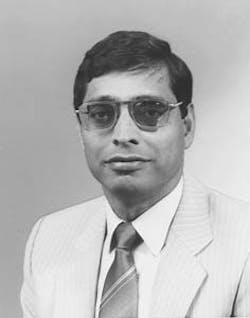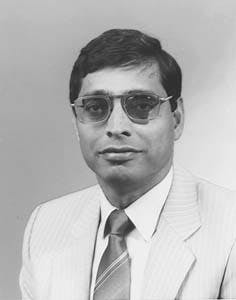PVT DATA USEFUL FOR DESIGN OF OIL PRODUCTION FACILITIES
Shashi Dharmadhikari
Petrotechna
Paris
A simple procedure for designing separators and related equipment has been developed to accurately establish the reservoir fluid composition from pressure-volume-temperature (PVT) analyses.
The performance of an actual oil production facility demonstrates that operational experience agrees well with the prediction based on the procedure.
Engineers not very familiar with PVT analysis for designing oil field separation equipment will find this procedure very useful.
Common Terms in PVT Analysis (50010 bytes)
PROCESS DESIGN
During development of an oil field, a number of crude oil samples are obtained downhole and then sent to a laboratory for specialized PVT analysis. This analysis determines reservoir fluid composition and derives such characteristics as dissolved gas content and residual oil density.
The process designer's task is to design the production facilities based on the PVT analysis. The design comprises the different gasoil separation stages and, depending upon crude conditions, the design may also include crude heating or cooling, gas compression, and gas disposal. During the design phase, the stage pressures are optimized to maximize the stabilized crude volume, and to minimize compression power if flashed gases are compressed.
To use the PVT analysis more efficiently for the facility design, it is recommended to constitute the reservoir fluid composition according to this procedure, calculate the main characteristics of the crude, and then check that the characteristics agree well with the PVT analysis.
FLUID COMPOSITION
The reservoir fluid composition given in the PVT analysis is based on chromatography. Because of the large variation in the boiling range, the heavy components are generally defined as pseudocomponents rather than normal paraffins. The basic physical properties (such as molecular weight and either normal boiling point or specific gravity) are calculated from the boiling range.
Table 1 (17382 bytes) shows the reservoir fluid composition obtained from the PVT analysis of an oil field in France. Note that the heavier components from C6 are termed as pseudocomponents, for which only composition is given. Moreover, all components C12 and heavier are grouped together as a single component C12+, providing its basic physical properties. Finally, note that the C12+ component constitutes more than 42% of the total composition.
If one simulates separation stages using the reservoir fluid composition as such, it would give 20% error in the saturation bubblepoint pressure, and more than 40% error in GOR.
CRUDE CHARACTERISTICS
Some of the characteristics obtained from the PVT analysis are more important, and these must be well matched before carrying out the process design.
The most important characteristic is the reservoir fluid bubblepoint pressure at well temperature. A 10% error in the bubblepoint pressure yields about 20% error in GOR and 10% error in stock-tank oil density.
Once the reservoir fluid bubblepoint pressure, as determined by the process simulation, matches the value obtained from the PVT analysis, then other crude characteristics are easily matched.
Solution gas-oil ratio is determined by successive flashing of the reservoir fluid, at different pressure levels, from the bubblepoint pressure to atmospheric pressure.
Oil density of the stock tank oil is generally specified as API gravity.
Reid vapor pressure (Rvp) is the internationally recognized method of specifying the vapor pressure of stored stabilized oil (Refer to ASTM D323). Most simulation software can calculate this property directly from the given composition.
Once these parameters are matched, it is also desirable to check other physical properties, such as density and viscosity, of both gas and liquid phases at separation stages to obtain a reliable process model.
FLUID COMPOSITION
The minimum information necessary for any pseudocomponent is its basic physical properties such as molecular weight, normal boiling point, and specific gravity at 15 C. In Table 1 (17382 bytes) , these properties are specified only for C12+. It would be impossible to guess these properties for other pseudocomponents, C6 to C11, and then iterate until the characteristics of the simulated reservoir fluid agrees with those in the PVT analysis.
The simple seven step method is as follows:
- Specify all the components except the heaviest component as normal paraffins.
- For the heaviest component, C12+ in the given example, specify the basic physical properties as given in the PVT analysis. Simulation software generally needs any two of three basic properties to generate remaining thermodynamic properties from the built-in correlations. Table 2 (37681 bytes) shows the properties generated by the Hysim software for the given example.
- Using these data, calculate the molecular weight of the reservoir crude and compare it to the value given in the PVT analysis. If both do not agree, vary the molecular weight of the heaviest pseudocomponent until the two values are equal.
- Calculate the bubblepoint pressure of the reservoir fluid at reservoir temperature. If this agrees to the value of the PVT data (this is a rare case unless you are very lucky), go to Step 7.
- Note values of the following parameters calculated by the software for the heaviest component:
- Critical pressure (Pc)
- Critical temperature (Tc)
- Acentric factor (w)
- Vary each of the parameters of Step 5 until the calculated bubblepoint pressure matches the value derived from the PVT analysis. The variation needed for each variable depends on the nature of the reservoir crude but should not exceed -- 20%.
Moreover, certain parameters may have more influence than others. For the present example, it was necessary to vary the critical pressure by only 2%, the other parameters needed about 20% variation.
Fig. 1 (62514 bytes) shows the sensitivity analysis for three parameters of the example. It can be seen that different parameter combinations can yield the required result. Therefore, further checks on other crude characteristics are essential for determining that the correct parameter values are selected.
- Once the bubblepoint pressure agrees, tune the other characteristics. For example, if the reservoir fluid viscosity is not matched, vary one or more viscosity correlation constants in the software.
Table 3 (14050 bytes) gives the calculated and adjusted parameters of the heaviest component for the given example. Using these adjusted parameters, the reservoir crude bubblepoint pressures for different temperatures are calculated. The results are presented in Fig. 2 (43080 bytes), and compared to those derived from the PVT analysis. As can be seen, the modified parameters of the heaviest pseudocomponent result in a good prediction.
Sometimes the PVT analysis provides the basic physical properties for all pseudocomponents. In such a case, one can still follow the above-mentioned procedure, specifying all pseudocomponents with their basic properties, and varying the critical properties of only the heaviest pseudocomponent as per Step 5 of the proposed procedure.
DIFFERENTIAL LIBERATION
Differential liberation is the gradual depletion of the reservoir crude from the original reservoir bubblepoint pressure to near-atmospheric pressure at constant temperature, usually reservoir temperature.
Fig. 3 (76312 bytes) compares the calculated characteristics to those given by the PVT analysis by differential vaporization of the crude in the example. The viscosity of the flashed crude at different pressures is similarly compared in Fig. 4 (42337 bytes). These figures show that the predicted characteristics agree well with the PVT analysis.
Differential vaporization, however, is a purely theoretical phenomenon as all flashing is assumed to take place at constant reservoir temperature. The actual GOR (or GLR) of the crude may be very different to that calculated by differential vaporization.
Stepwise flash calculations are therefore run to find the real GOR expected. The calculations are made for two or three separation stages, at conditions related to the expected facility operating conditions.
For three-stage separation, Table 4 (20756 bytes) compares the results obtained from a process simulation with those from the PVT analysis. The process simulation yields the main crude characteristics with less than 5% error.
FACILITY PERFORMANCE
The process design of the oil field production facility, selected as an example, was based on the reservoir fluid composition determined from the proposed procedure.
The crude is treated in two separators in series, operating at 5 and 3 bara (73 and 43 psia) respectively. The pressure of each separator is selected from an optimization study during the basic engineering phase. The treated crude is stored in an atmosphere tank and eventually pumped into the existing pipeline. The effluent water from the separators is treated in a corrugated separator before entering atmospheric storage.
Fig. 5 (79134 bytes) shows a simplified flow scheme of the process facility.
This facility was started up late in 1993, without any major problem. More recently, facility data have verified the validity of the process model developed from the PVT analysis. The facility data were collected at two different inlet crude temperatures: 36 and 46 C. (97 and 115 F.).
For both temperatures, the actual facility performance agrees well with the predicted characteristics at each separation stage (Fig. 6) (81897 bytes).
ACKNOWLEDGMENT
The author expresses his gratitude to ESSO Rep, France, for assistance in providing facility operation data, and also for permission to publish the data on the crude.
THE AUTHOR
Before joining Petrotechna, he worked with Technip, France, and Air Products in England. Dharmadhikari has a PhD from the University of Surrey, England, and is a Fellow of the Institution of Chemical Engineers, U.K. He holds the title of European Engineer (Feeni, Paris)
Copyright 1995 Oil & Gas Journal. All Rights Reserved.

